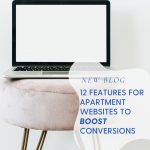
Apartment marketing copywriting can make it or break it when it comes to getting more leases. The secret sauce to filling those vacant apartments isn’t just about the amenities; it’s how you write about them. Good copywriting is essential for apartment marketing because it serves as the bridge between a property and its potential renters.
It not only communicates the tangible features but also crafts an emotional narrative that helps individuals envision themselves living there. It is an essential step in creating a compelling, persuasive message that can turn casual interest into committed renters, making it a critical element in a successful apartment marketing strategy. Providing the best website visitor experience means that you are dedicated to professional wording and better website engagement.
The Basics of Copywriting
What is Copywriting?
Copywriting is the art and science of crafting written content, typically for marketing and advertising purposes.
The primary goal is to persuade and engage the reader. Copywriters use carefully chosen words, tone, and style to create compelling and persuasive messages that drive action, whether it’s making a purchase, signing up for a newsletter, or simply gaining a deeper understanding of a product, service, or idea.
Effective copywriting is about more than just conveying information; it’s about connecting with the audience on an emotional level, addressing their needs and desires, and compelling them to take a specific desired action, such as buying a product, subscribing to a service, or engaging with a brand.

Types of Copywriting
Copywriting encompasses various types tailored to specific purposes and mediums. Content copywriting focuses on creating informative and engaging content, such as blog posts, articles, and educational materials, to provide value and build brand authority. Advertising copywriting is geared toward creating persuasive ad campaigns for various media like print, radio, TV, and digital platforms. SEO copywriting involves optimizing web content to improve search engine rankings while maintaining readability and relevance.
Social media copywriting focuses on crafting concise, engaging messages for social media platforms to spark interaction and brand engagement. Technical copywriting deals with complex or highly specialized subjects, often found in industries like technology or healthcare, requiring clear and accurate communication. Each type of copywriting serves distinct purposes, tailored to the communication goals and channels of a particular marketing strategy.
The Psychology Behind Effective Copywriting
Successful copywriting leverages psychology to influence and engage readers. It taps into principles like emotional appeal, using language that resonates with readers on a personal level, creating a connection, and fostering trust. Scarcity and urgency are also powerful psychological triggers, encouraging action by making readers fear missing out on an opportunity. Social proof showcases that others have had positive experiences, providing reassurance and validation. Storytelling engages readers’ imaginations and emotions, making the message memorable and relatable.
Additionally, clarity and simplicity reduce cognitive load, making it easier for readers to understand and act upon the message. By understanding these psychological drivers, effective copywriting can persuade, motivate, and drive desired behaviors, whether it’s making a purchase, signing up, or simply connecting with the brand’s message.
- According to Psychology Today, the brain processes images 60,000 times faster than text. Use visuals to complement your copy.
- A study by Nielsen found that 85% of consumers regularly or occasionally seek out trusted expert content when considering a purchase.
- According to a report by Animoto, 73% of consumers are more likely to make a purchase after watching videos explaining a product or service.
- A study by the CMO Council found that 46% of marketers consider storytelling to be critical in modern marketing.
- According to a report by Demand Gen, 47% of buyers view at least 3 to 5 pieces of content before deciding to speak with a sales rep.
Understanding Apartment Marketing
Apartment Strategy Challenges
Apartment marketing faces multiple challenges: intense competition, changing market conditions, and balancing cost-effectiveness with quality. Standing out in crowded markets requires innovative strategies to attract and retain tenants. Additionally, the ever-evolving digital landscape demands adaptation to new technologies and marketing trends, which can be daunting.
Compliance with regulations and fair housing laws is vital but complex. Seasonal demand variations, high tenant turnover, and the impact of negative reviews further complicate marketing efforts. Identifying and targeting the right audience with diverse preferences can also be challenging. Ensuring consistent branding and maintaining property quality is crucial for success. Overcoming these obstacles demands a blend of market research, strategic planning, effective advertising, and a deep understanding of tenant needs and market dynamics.
Apartment marketing through copywriting is not just about filling space with words; it’s a strategic approach that combines market research, content optimization, and psychological triggers to convert casual browsers into committed renters.
Target Audience in Apartment Marketing
Finding your target audience in apartment marketing involves a systematic approach. Start by conducting market research to understand the demographics, preferences, and behaviors of potential renters in your area. Analyze data from previous tenants to identify trends. Utilize online tools and platforms like social media and digital advertising to reach specific demographics effectively. Collaborate with local real estate agents and property managers who have insights into the local market.
Consider the unique features and amenities of your apartments and tailor your marketing messages accordingly. Lastly, collect and analyze data from your marketing efforts to refine your audience targeting over time. Finding your target audience requires a combination of data-driven insights, market knowledge, and ongoing refinement to ensure your marketing efforts are reaching the right people.

Key Metrics to Track
Measuring the effectiveness of apartment marketing campaigns involves tracking various key metrics to assess performance and make data-driven decisions. Here are some of the key metrics to consider:
Website Traffic: Monitor the number of visitors to your apartment community website. Analyze the sources of traffic (organic, paid, social) to understand which channels are driving the most interest.
Conversion Rate: Calculate the percentage of website visitors who take desired actions, such as filling out a contact form, scheduling a tour, or signing up for a newsletter.
Cost Per Lead (CPL): Determine how much you’re spending to acquire each lead. This metric is crucial for evaluating the efficiency of your advertising campaigns.
Click-Through Rate (CTR): For online ads, measure the CTR to gauge the effectiveness of your ad copy and creativity in driving traffic to your website.
Return on Investment (ROI): Calculate the ROI of your marketing efforts by comparing the cost of your campaigns to the revenue generated from rented apartments.
Lease Conversion Rate: Track the percentage of leads that ultimately convert into signed leases. This metric directly reflects the effectiveness of your marketing in converting leads into tenants.
Average Time to Lease: Measure the average amount of time it takes to turn a lead into a tenant. A shorter time frame indicates a more efficient leasing process.
Retention Rate: Assess how many tenants renew their leases. High retention rates can reduce the need for continuous marketing to fill vacancies.
Cost Per Acquisition (CPA): Calculate the cost per new tenant acquired through your marketing efforts, factoring in all expenses related to marketing and advertising.
Social Media Engagement: Monitor the engagement metrics on your social media platforms, including likes, shares, comments, and click-throughs to your website.
Email Marketing Metrics: For email campaigns, track metrics like open rates, click-through rates, and conversion rates to assess the effectiveness of your email marketing efforts.
Review and Reputation Metrics: Keep an eye on online reviews and ratings. Monitor changes in your property’s reputation and address negative feedback promptly.
Competitive Analysis: Compare your marketing performance metrics to those of your competitors to identify areas for improvement and benchmark your success.
Regularly reviewing and analyzing these key metrics will help you refine your apartment marketing strategies, optimize your budget allocation, and improve your overall marketing effectiveness.
Data and Facts
- According to a study by HubSpot, personalized CTAs convert 202% better than generic ones. Personalization in apartment marketing can significantly boost engagement.
- A Google study found that 63% of people expect brands to use their purchase history to provide them with personalized experiences. This is crucial for retargeting campaigns.
- According to the Content Marketing Institute, 91% of B2B marketers use content marketing to reach customers. Even in the apartment industry, content is king.
- A survey by the National Apartment Association reveals that 76% of renters visit at least three websites before making a decision. Your copy needs to stand out.
- According to Statista, 27% of all internet users say they find new products through paid social ads. Paid social can be a key component of your apartment marketing strategy.
Copywriting Techniques for Apartment Marketing
Writing Headlines that Convert
To write headlines that convert, focus on clarity, relevance, and persuasion. Begin by understanding your target audience’s needs and desires, then craft a headline that addresses a specific pain point or offers a clear benefit. Use concise language and avoid jargon, making sure your headline is easy to understand. Emphasize the value your content or offer provides, incorporating emotional triggers when appropriate. Creating a sense of urgency or scarcity can also encourage action.
Test different headlines to see what resonates best with your audience, and don’t forget to optimize for the platform where it will be displayed. Finally, always deliver on the promise made in your headline to build trust and credibility with your audience.
Crafting Compelling CTAs
The first step is to make your CTA clear and easy to understand. Use concise and action-oriented language that tells the user exactly what you want them to do. Use verbs like “download,” “subscribe,” “shop now,” or “learn more” to guide their actions. Avoid vague or passive language. The CTA should leave no room for ambiguity about the desired action.
Convey the value or benefit the user will receive by clicking the CTA. Explain why taking this action is in their best interest. For example, instead of “Click Here,” use “Get 20% Off Today” or “Start Saving Now.” The CTA should create a sense of urgency or demonstrate how the user will solve a problem or fulfill a need by clicking.
The visual design and placement of your CTA matter. Use contrasting colors that stand out from the surrounding content, making the CTA button or text easily noticeable. Position it prominently on the website page where users are likely to see it without excessive scrolling. Ensure that it’s mobile-responsive for users on different devices. A well-designed and strategically placed CTA can significantly impact its effectiveness.
- A/B testing your CTAs can improve conversion by as much as 300%, according to a report by Venture Harbour.
- According to Neil Patel, the average reader only consumes 20% of the content on a web page. Make your copy scannable.
- A study by Microsoft found that the average human attention span is 8 seconds, shorter than that of a goldfish. Keep your messages concise.
- According to a report by Econsultancy, 74% of marketers say targeted personalization increases customer engagement.
- A study by Forrester found that emotion was the #1 factor in customer loyalty. Emotional storytelling can be a game-changer.
SEO in Apartment Marketing Copywriting
To use SEO in apartment marketing copywriting, start by conducting keyword research to identify relevant search terms and phrases that potential renters might use when looking for apartments in your area. Integrate these keywords naturally into your copy, including in headlines, subheadings, and body content. Craft high-quality, informative, and engaging content that addresses the needs and questions of your target audience while incorporating these keywords. Optimize meta tags, such as title tags and meta descriptions, with relevant keywords.
One way to easily incorporate more keywords is to start blogging on your apartment website. You can highlight local events and attractions, tell resident stories, and get hyperlocal about what goes on in your neighborhood. Your local SEO can only get better when you have a blog.
Additionally, ensure that your apartment website is technically sound, loads quickly, and is mobile-friendly, as these factors also impact SEO rankings. Finally, consider local SEO strategies by including location-based keywords, creating Google My Business listings, and encouraging reviews from satisfied tenants to boost your visibility in local search results.
- According to Moz, a well-structured URL can result in a 25% improvement in click-through rates. Optimize your URLs for SEO.
- A study by Backlinko found that the average Google first page result contains 1,447 words. Long-form content can improve your SEO ranking.
- According to a report by Ascend2, 82% of marketers see SEO as becoming more effective, with 42% stating that its effectiveness is increasing significantly.
- A study by Ahrefs found that 90.63% of all pages get zero traffic from Google. On-page SEO is not just an option; it’s a necessity.
Storytelling in Apartment Marketing
Storytelling in apartment marketing involves weaving a compelling narrative around the property to engage and connect with potential renters. Start by identifying the unique features and benefits of the apartment complex, such as its location, amenities, and community atmosphere. Then, craft a story that illustrates how living in this environment can transform tenants’ lives.
Sharing real tenant stories and testimonials can also enhance your storytelling by providing authentic and relatable experiences. Overall, storytelling in apartment marketing humanizes the property, making it more than just a place to live but a backdrop for a richer, more fulfilling life.
The AIDA Model
The AIDA model is a classic marketing and advertising framework that stands for Attention, Interest, Desire, and Action. It represents the stages a consumer typically goes through when exposed to a marketing message. First, you grab their attention with a compelling headline or visual. Next, you pique their interest by providing information about the product or service.
Then, you cultivate desire by showcasing its benefits and value. Finally, you prompt them to take action, such as making a purchase or signing up. The AIDA model serves as a guide for crafting persuasive marketing content that leads consumers from initial awareness to conversion.

Practical Tips and Tools
Copywriting Tools for Marketers
Apartment marketers can benefit from a range of copywriting tools to enhance their content creation and marketing efforts. Here are some of the best copywriting tools for apartment marketers:
Grammarly: Grammarly is a powerful proofreading and grammar-checking tool that helps ensure your copy is error-free and polished.
Hemingway Editor: This tool helps you simplify and improve the readability of your writing by highlighting complex sentences and suggesting alternatives.
CoSchedule Headline Analyzer: Craft attention-grabbing headlines with this tool that provides feedback on the emotional appeal, word balance, and overall quality of your headlines.
BuzzSumo: Discover trending topics and content in your industry to generate ideas and insights for your apartment marketing copy.
Canva: Create visually appealing graphics and social media posts to accompany your copy with this easy-to-use design tool.
Trello or Asana: These project management tools help you organize your content calendar, collaborate with team members, and ensure your copy is consistently delivered on time.
Google Analytics: Monitor the performance of your website and content to assess the effectiveness of your copy and make data-driven improvements.
Email Marketing Platforms (e.g., Mailchimp, Constant Contact): These platforms offer email copy templates and automation features to streamline your email marketing campaigns.
Social Media Schedulers (e.g., Buffer, Hootsuite): Schedule and manage your social media posts with these tools, which often come with content planning and analytics features.
Customer Relationship Management (CRM) Software: Tools like HubSpot or Salesforce can help you manage and personalize communication with potential renters, enhancing your copywriting efforts in email and messaging.
Common Apartment Marketing Copywriting Mistakes
Common apartment copywriting mistakes include a lack of differentiation, where properties fail to highlight what sets them apart from competitors, resulting in bland and forgettable messaging. Another error is neglecting to address the target audience’s specific needs and desires, leading to generic content that doesn’t resonate. Overly technical or jargon-laden language can alienate potential renters, as can verbose and unclear writing.
Focusing solely on features and neglecting the emotional appeal of a property can also be a mistake, as people seek homes that evoke feelings of comfort and security. Finally, overlooking the importance of proofreading and editing can lead to grammatical errors and typos that diminish professionalism and credibility. To craft effective apartment marketing copy, it’s crucial to address these pitfalls and create content that speaks directly to the audience’s desires while highlighting the unique qualities of the property.

Work With Apartment Copywriters
Working with apartment copywriters can significantly benefit property managers and real estate professionals. These specialized writers have the expertise to create compelling and persuasive content tailored to the unique demands of the apartment rental market. They understand how to highlight the features and amenities of a property effectively, craft engaging narratives that resonate with potential tenants, and employ SEO strategies to improve online visibility.
Apartment copywriters also stay updated on industry trends and can adapt marketing messages accordingly. By outsourcing copywriting tasks to professionals, property managers can save time and resources while ensuring their property website is optimized for attracting and converting renters, ultimately resulting in higher occupancy rates and revenue.
- According to a report by Gartner, companies that automate lead management see a 10% or more bump in revenue within 6-9 months.
- A study by Adobe found that companies with the strongest omnichannel customer engagement strategies enjoy a 10% Y-O-Y growth.
- According to a report by Salesforce, 57% of marketing leaders stated that AI is essential in helping them provide personalized experiences.
- A study by McKinsey found that customer satisfaction is 30% more correlated to perceived value than to customer service quality.
- According to a report by Deloitte, 56% of consumers are willing to share data to get faster and more convenient service.
Work with Market Apartments today!
Categorised in: Apartment Marketing, Market Apartments Services
This post was written by Isabella Housel
Isabella Housel is a passionate and versatile professional writer with a deep love for words and a commitment to crafting compelling content that engages, informs, and inspires. With many years of experience in the industry, she has honed her skills across various genres, from creative storytelling to informative articles and technical documentation.





